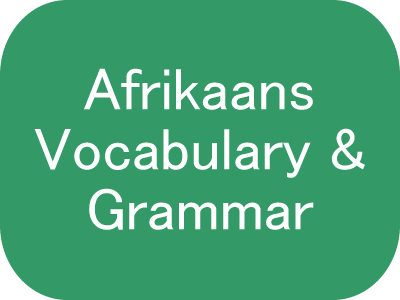Afrikaans Verb Tenses
How to use Afrikaans verbs in past, present, and future tenses
Need more Afrikaans? Try the audio and video lessons at AfrikaansPod101.com

Afrikaans Verb Tenses
Verbs in Afrikaans are used in only three tenses: present, past, and future. As you saw with the verbs wees - to be and hê - to have, the conjugated forms for each person/pronoun are exactly the same, e.g. ek is, jy is, hy is, etc. The infinitive is identical to the present tense as well as the imperative (command form), except for wees and hê. In general, you will only need to learn two forms for each verb: the infinitive/present/imperative form and the past form.
Present
The present can be expressed in various ways in English: I read, I am reading, I do read. There is only one form of the present tense in Afrikaans. Verbs with separable prefixes, such as aan-, op-, toe-, uit-, place this prefix at the end of the sentence in the present and imperative. If there are two verbs in the sentence, such as a modal/helping verb and an infinitive, the infinitive goes to the end.
Past
The past can also be expressed in various ways in English: I watched, I have watched, I was watching, I have been watching, I did watch. For most verbs in Afrikaans, the past tense is formed by using het (have/has) and the past participle, which is usually created by adding the prefix ge- to the infinitive. The past participle is placed at the end of the sentence.
Verbs beginning with inseparable prefixes, such as be-, er-, her-, ont- and ver-, do NOT add ge- to form the past participle. (This means that there is only one form of these verbs; the infinitive, present, imperative and past participle are all identical).
Verbs beginning with separable prefixes place -ge- BETWEEN the separable prefix and the verb stem.
Only a few verbs in Afrikaans (wees and the modals) use the simple one-word past tense instead of het + past participle.
Future
For the future tense, use sal with the infinitive just as we use will with the infinitive in English. The infinitive of the main verb is placed at the very end of the sentence. Any objects must go before the infinitive. (It is also possible to use gaan like in English, to express to be going to + infinitive.)
Ek sal die boek lees. I will read the book. (literally: I will the book read)
Negation
For basic negation, add nie (not) after the main verb and another nie at the end of the sentence. The second nie is not required if the sentence only contains a subject + a verb or a subject + a verb + a personal object (either a pronoun or noun).
Ek weet nie. I don't know. (subject + verb; second nie not required)
Hy praat nie Russies nie. He doesn't speak Russian. (subject + verb + non-personal object; second nie required)
To Love
The verb to love has some pecularities in Afrikaans. The infinitive is liefhê and so it is conjugated with lief as a separable prefix: Ek het lief. However, is lief is much more commonly used for the present tense: Ek is lief (I love). The past tense (I loved) is ek het lief gehad. If using a personal pronoun or noun, the preposition vir is placed before it. Therefore, I love you is Ek is lief vir jou while I loved you is ek het jou lief gehad. (It is of course possible to say Ek het jou lief in the present tense as well, but it is not as common.)

If you enjoy the tutorials, then please consider buying French, Informal French, Italian, Spanish, German, Swedish, or Dutch Language Tutorials as a PDF e-book with free mp3s and free lifetime updates.
Buy French TutorialBuy Informal French
Both French e-books
Buy Italian Tutorial
Buy Spanish Tutorial
Buy German Tutorial
Buy Swedish Tutorial
Buy Dutch Tutorial
Please consider sending a donation of any amount to help support ielanguages.com. Thank you!
FluentU offers authentic videos in French, Spanish, German, English, Chinese and Japanese. Learn from captions and translations and enjoy access to ALL languages!
Learn Spanish, French, German, Italian, Mandarin Chinese and English with authentic videos by Yabla that include subtitles and translations.
Learn to read languages with interlinear bilingual books that include the original language and an English translation below in a smaller font.
Hundreds of free and paid online language learning video courses at Udemy. By native speakers and experts, from Arabic to Zulu.




